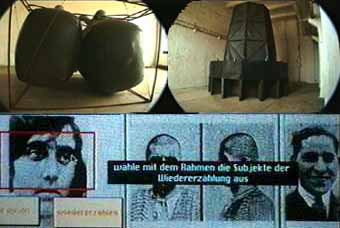|
Violence is an omnipresent expression of one's inability to express oneself. In the societies of the modern industrial nations, where communal coexistence is turning into social tightness and instinct and intuition are being replaced by laws and controls, the occurrence of human and system breakdowns is becoming increasingly accepted and even expected. The analysis of these coarse symptoms, abnormal behaviour and frightening events is not left to just the humanities.
The artistic study of the own existence with the world around us has brought artists with very different philosophies, such as Olaf Arndt, Rob Moonen, Niels Peters and Alexander Thiele together in this exhibition. The center point of the exhibit is not the sensation, but rather the analytic attempt to translate the inexplicable and unimaginable into artistic expressions.
Arndt, Moonen and Peters researched recent German history for their project BUNA 4. During the second World War, prisoners and deportees were forced to work in German factories under unimaginable conditions.
One example is the rubber plant of the chemical factory in Buna, later IG Paints. The artists used the materials of this production to create a gigantic sculpture. By walking through the sculpture, the texture, smell, and optical and acoustic stimuli evoke an associative shock in the viewer.
Alexander Thiele works with the same material. He developed the Breathing Machine, a kinetic object that almost traumatically studies physical and psychological conditions.
(following text in german only)
Richard Schütz und Kerstin Weiberg demonstrieren mit ihrer Arbeit "D-Konstruktion des Erinnerns" (Hypertextarchiv/Installation zum Anti-semitismus) das prozessuale Verhalten von Dokumenten und den Verlust von Erinnerung.
Archive sind Manifeste des kollektiven Gedächtnisses. Das Festhalten von historischen Abläufen in Dokumenten und deren Aussage ist jedoch von den Umständen der Zeit und der Gesellschaft beeinflußt. In der Arbeit von Richard Schütz und Kerstin Weiberg sind die verschiedenen Archivdaten - Texte, Bilder, Stimmen-, zur 1700-jährigen Geschichte des Antisemitismus Im Computer archiviert. Hierbei entsprechen Text-, Bild- und Tondokumente verschiedenen Ebenen der Erinnerung.
Die Daten können vom Publikum aufgerufen und bearbeitet werden. Textdokumente werden auf dem Bildschirm angezeigt. Die Bilddokumente werden über Videoprojektoren an die Wände des Raumes projiziert. Ihre Präsenz und ihr Zustand ist von der Nutzung des Archivs abhängig, denn die Dokumente werden vom Dahinschwinden durch die voranschreitende Zeit bedroht. Der Verfall der Dokumente tritt bereits wenige Augenblicke nach dem letzten Benutzerimpuls ein. Computerviren beginnen das jeweils aufgerufene Text-, und Bilddokument zu zerstören. Texte werden unlesbar; Bilder mit dokumentarischen Inhalten werden zu "abstrakten" Mustern. "Zurück bleibt die subjektive Erinnerung an die Fragmente des Wahrgenommenen..." (Schütz/Weiberg)
|
